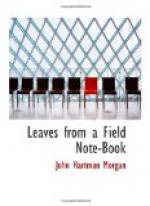A mile or two from the battery headquarters at X—— Y—— was the observing station. The battery-major and myself were accompanied thither by a huge mastiff who in civil life was a dairyman by profession and turned a churn, but had long since attached himself to the major as orderly. We duly arrived at a deserted farm, but at this point the mastiff stopped dead and declined to come any further. I thought this churlish, and told him so, but he merely wagged his tail. When we entered the farmyard I understood. It was pitted with shell-holes, and they were obviously of very recent excavation. As a matter of fact the Huns suspected that farm, and with good reason, and treated it to intermittent “Hate.” The mastiff therefore always waited for the battery-major at what it judged, quite erroneously, to be a safe distance. We clambered up into a loft by means of unreliable ladders. In the roof of the loft some tiles had been removed, and leaning our arms on the rafters we looked out. “You see that row of six poplars over there?” said the Major, pointing to a place behind the German trenches. I recognised them, for the same six poplars I had seen through a periscope in the trenches the day before. “Well, you see the roof of a house between the second and third tree from the right? Good!” He turned to the telephone operator in the corner of the loft. “Lay No. 2 on the register! Report when ready!” The operator repeated the words confidentially to the distant battery, and even as he spoke the receiver answered “Ready!” “Fire!” I had my eyes glued to the house, yet nothing seemed to happen, and I rubbed my field-glasses dubiously with my pocket-handkerchief. Had they missed? Even as I speculated there was a puff of smoke and a spurt of flame in the roof of the house between the poplars. We had delivered the goods.
If one of those ruinous farms does not contain a battery mess the chances are that it will shelter a field ambulance or else a company in billets. Field ambulances, like the batteries, are somewhat migratory in their habits, and change their positions according as they are wanted. But a field ambulance is not, as might be supposed, a vehicle but a unit of the R.A.M.C, with a major or a colonel in charge as O.C. The A.D.M.S. of a division has three field ambulances under him, and when an attack in force is projected he mobilises these three units at forward dressing stations in the rear of the trenches. They are a link between the aid-posts in front and the collecting stations behind. From the collecting stations the wounded are sent on to the clearing hospitals and thence to the base. It sounds beautifully simple, and so it is. The most eloquent compliment to its perfection was the dreamy reminiscence of a soldier I met at the base: “I got hit up at Wipers, sir; something hit me in the head, and the next thing I knew was I heard somebody saying ‘Drink this,’ and I found myself in bed at Boulogne.” Every field ambulance has




